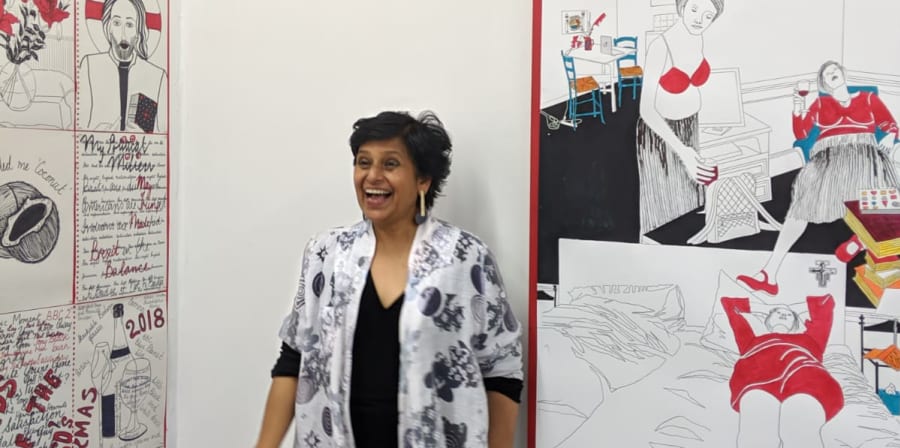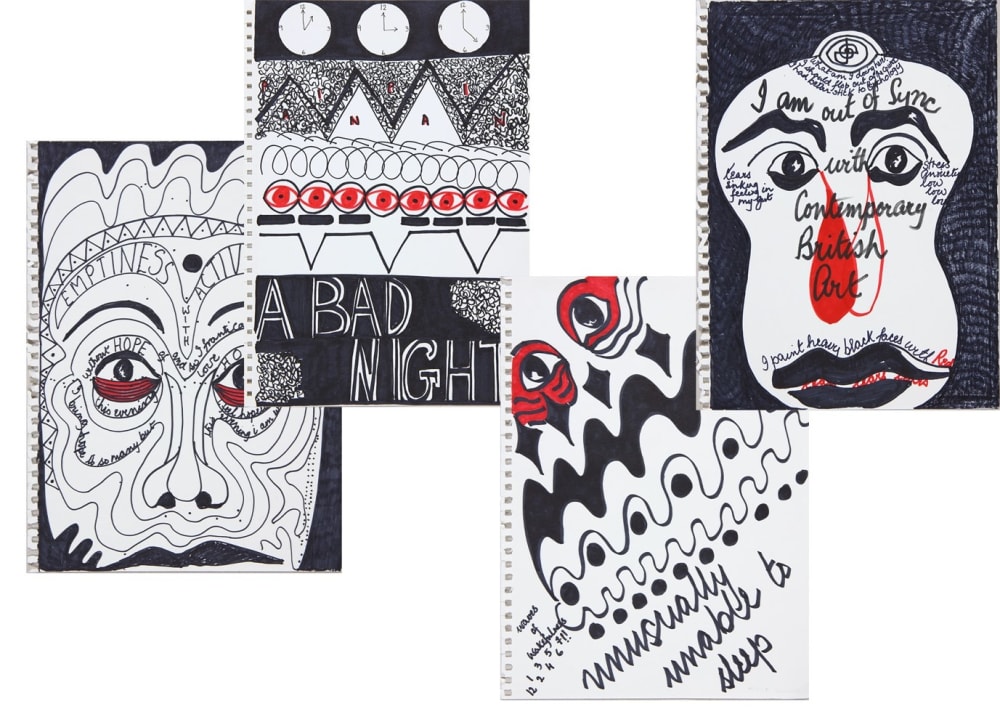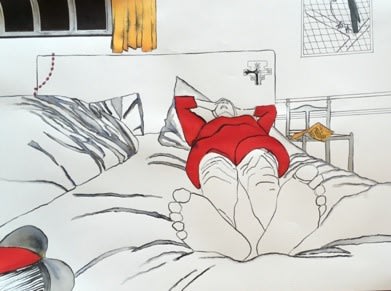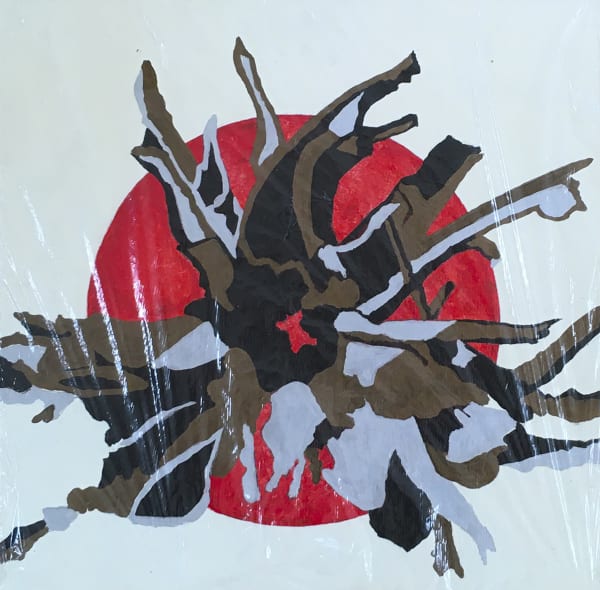Nimmi Hutnik MA Painting Wimbledon College of Arts Graduate 2019 talks to UAL's Post-Grad Community about being selected for the Bloomberg New Contemporaries 2020 exhibition.

Life has not always been a bed of roses, in fact it is an emotional roller coaster. So I thought I would document the many failures I experienced as a student, rather than my success, just so that you can feel encouraged and find the inner strength to persist and carry on.
Before coming to UAL, I had been an academic and a researcher, looking into what makes people resilient. I had seen resilience in nature a lot. While living in Surrey, I had come across a huge tree that had been uprooted and had lain on it back for who knows how many years. But there from its helpless position on the earth, it had sprouted new trees from the body of its trunk. I too had been uprooted from my home country, India, and had emigrated to Britain. I too had had to start again. Via fellow student and friend Gabriel Chaim, I discovered the use of gold leaf (which traditionally had been used to embody the sacred) and bitumen. I also thought there was a resilient quality to gold and juxtaposing it with black, which to me symbolises the dark night of the soul, made for a symbolic quality to the work.
I have always had a deep relationship with the sun as an emblem of the spiritual. So, here are some of the paintings I produced in the first term of the course.
None of the above met the mark, of course, nobody was impressed and I felt a failure and very discouraged.
I was floundering…
In times like these, I turn to spirituality to ground myself and I discovered some fascinating concepts in Zen Buddhist philosophy: life is imperfect, impermanent and incomplete. These are the cornerstones of Wabi-Sabi and they are to be found in the Christian mystics too like Meister Eckhart, Julian of Norwich and more recently Anthony DeMello and Richard Rohr
What was the origin of Wabi Sabi? The story goes that Sen no Rikyu was a Buddhist monk in the household of General Hideyoshi, a man of some standing in 16th Century Japanese society. Rikyu was disquieted by the fact that the Japanese tea ceremony, which was meant to be an act of meditation, of being totally present in the now, had become an empty ritual, the monopoly of the rich who used it to display status and wealth via the ornate, gold- embossed tea utensils sourced from China that they used for the ceremony. Rikyu instead began to use rustic, locally made, unadorned tea utensils, thereby restoring the Tea Ceremony to the common people, thus gaining a massive following. Hideyoshi hated the raw aesthetic propounded by Rikyu and, it is said, became jealous of Rikyu’s popularity. So, he ordered Rikyu to revoke his aesthetic and his beliefs or commit hara-kiri (ritual suicide by disembowelment). Rikyu chose suicide rather than give up his belief in rustic simplicity, directness of approach and honesty of the self—all of which were embodied in wabi-cha or the Tea ceremony.
I asked myself: “How can I embody rustic simplicity, directness of approach and honesty of the self in my art?” I chose the very early morning, 6am, as the time to quieten and centre the soul in simple acts of meditation. I chose sketchbooks as my canvases and sharpies as my paint brushes, and I began to create. Using the Buddhist concept of ‘beginner’s mind’, I faced an empty sketchbook page every (or nearly every) morning and waited for an image to emerge. Sometimes I merely recorded my surroundings, painting the scene outside my bedroom window, or within my bedroom, or within my home. Other times I was attentive to the emotions rising within me or ones that I experienced within my clients (I still practice as a psychologist). I developed a kind of meditative art practice and some of the 6 am paintings documented how rubbish I felt during the course.
You can see that I’ve had many sleepless nights doing the course, feeling completely out of sync with contemporary British life, feeling empty and hopeless.



I now have over two hundred 6am paintings. Themes that have emerged focus on ageing, sexuality, spirituality, politics, relationships and emotions such as depression, anxiety, sorrow, anger and loneliness. I am often riskily autobiographical because I want to embody the spirit of Wabi Sabi’s directness of approach and an honesty of the self. I painted and painted, like Yayoi Kusama. So, each sketchbook sheet is now part of a changeable, moveable tapestry of 6am paintings.
Here is a small selection of my 6am painting series:

Because I am a psychologist, I am often privy to the most intimate details of my clients’ lives. The Burnout Triptych and Friday Evening, which were the paintings selected by Bloomberg New Contemporaries 2020 (Burnout 1 was also selected to be included in the Trinity Buoy Wharf Drawing Prize exhibition of 2019), came directly from the empathy I felt towards people living in the contemporary world of work which is often Draconian in its demands and highly stressful.
Here is the Burnout Triptych and Friday Evening 1:




I had the privilege of being interviewed by one of my class mates, Caroline Streatfield about the confluence of my practice as a therapist and my art. She also asks me about new directions that my art is taking. Here is the interview:
One of the exciting new directions in my art is the concept of Kintsukuroi, another Japanese concept where broken ceramic pieces are mended with gold. The mended piece becomes more valuable and more beautiful because of the mending, not despite the mending. I see a parallel between this and my own practice as a therapist and have transposed this concept onto humans who are both broken and blest by the suffering in their life.
Here are two of the paintings I have done in this series:


So, if you are feeling discouraged, close to tears or despair, I encourage you to persist and not give up. Use my 5 min rule which is to paint or make something for at least 5 mins per day even when you are feeling like a rubbish artist. And after you graduate (or even in the year before you graduate), make sure you enter the Bloomberg New Contemporaries competition.
Exhibition Details
Bloomberg New Contemporaries 2020 opening from 13 Jan 2020 - 7 March 2021
at the South London Gallery, 65 Peckham Rd, London SE5 8UH.
Hope you get to see it!
All the best!
Dr Nimmi Hutnik (MA in Painting UAL Wimbledon College of the Arts)
Related Links:
Post-Grad Stories
A thriving online magazine of our postgraduate student voices sharing thought-provoking experiences, practices, thoughts and articles about what matters to them.
Open Call: Student stories/shares during COVID-19 Outbreak
Want to write an article? Get in touch with the Post-Grad Community team PGCommunity@arts.ac.uk








